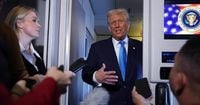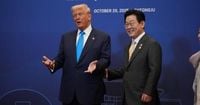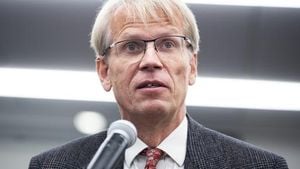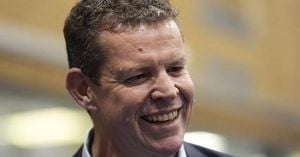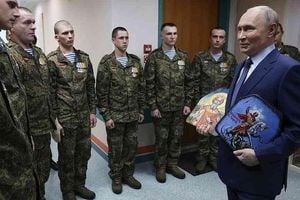In a move that has sent ripples across the globe, President Donald Trump announced on October 29, 2025, that the United States will share its closely guarded nuclear submarine propulsion technology with South Korea. The decision, made public during Trump’s multi-day visit to South Korea and detailed in a series of Truth Social posts, marks a dramatic shift in U.S. policy and signals a new era in the military alliance between Washington and Seoul.
The announcement came after a high-profile meeting between President Trump and South Korean President Lee Jae Myung in the historic city of Gyeongju, coinciding with the APEC summit. Both leaders emphasized the need to modernize their alliance, with Lee explicitly requesting U.S. support for nuclear fuel for submarines—not for nuclear weapons, but to power conventionally armed vessels capable of extended patrols in increasingly contested regional waters.
“We’re not aiming for nuclear-armed submarines, but rather, conventionally armed submarines powered by nuclear energy,” Lee said through a translator, according to AP. He elaborated that South Korea’s existing fleet of diesel-powered submarines faces “limited capabilities” and “cannot really effectively monitor and counter any undersea activities from other countries.” Diesel-electric submarines, while effective in some respects, must surface regularly to recharge batteries, limiting their endurance and stealth compared to nuclear-powered counterparts.
Trump’s decision to greenlight the transfer of such sensitive technology is unprecedented in the context of U.S. alliances in East Asia. Historically, the United States has fiercely protected its nuclear submarine know-how, sharing it only with the United Kingdom in the 1950s and, more recently, with Australia as part of the AUKUS agreement. Even then, direct technology transfer has remained rare.
“Our Military Alliance is stronger than ever before and, based on that, I have given them approval to build a Nuclear Powered Submarine, rather than the old fashioned, and far less nimble, diesel powered Submarines that they have now,” Trump wrote on Truth Social, as reported by Reuters and NPR.
The submarine is set to be built at the Hanwha Philly Shipyard in Philadelphia, a commercial facility purchased by South Korea’s Hanwha Group in 2024. The choice of location is as symbolic as it is strategic, reflecting both nations’ desire to revitalize American shipbuilding and deepen economic ties. “Shipbuilding in our Country will soon be making a BIG COMEBACK,” Trump declared in a follow-up post.
South Korea has committed to invest a staggering $350 billion in the U.S., with $150 billion earmarked specifically for shipbuilding, according to statements from both governments. This investment comes as part of a broader trade agreement that also includes South Korea purchasing large quantities of American oil and gas and the U.S. lowering tariffs on South Korean goods from 25% to 15%.
Yet, the path forward is far from straightforward. The Hanwha Philly Shipyard, while a symbol of renewed cooperation, is not currently equipped for nuclear military shipbuilding. Transforming a commercial yard into a facility capable of handling nuclear material and constructing advanced submarines will require a massive overhaul, specialized training, and a skilled workforce—no small feat. Industry experts point out that the U.S. shipbuilding sector is already facing significant delays; Huntington Ingalls Industries, for example, is grappling with two- to three-year backlogs on Virginia-class submarines and similar bottlenecks for the new Columbia-class boats.
“Through Hanwha Philly Shipyard and other investments and partnerships, a revived American shipbuilding sector will benefit U.S. workers, foster prosperity for both the United States and Korea, and enhance our nations’ shared security,” said Alex Wong, Hanwha’s chief strategy officer, in a statement to Politico.
South Korea’s push for nuclear-powered submarines is not without its critics. Some U.S. and international experts question the necessity and wisdom of Seoul acquiring such capabilities. Daryl Kimball, executive director of the Arms Control Association, told Reuters, “As with the AUKUS deal, (South Korea) is probably looking for nuclear propulsion services suitable for subs, including the fuel, from the U.S. Such submarines usually involved the use of highly-enriched uranium and would require a very complex new regime of safeguards by the International Atomic Energy Agency.” He added, “It remains technically and militarily unnecessary for South Korea to acquire the technology to extract weapons-usable plutonium from spent fuel or to acquire uranium enrichment capabilities, which can also be used to produce nuclear weapons.”
The deal has also raised eyebrows in Beijing and Pyongyang. China’s foreign ministry spokesperson Guo Jiakun said, “We hope that South Korea and the United States will earnestly fulfill their nuclear non-proliferation obligations and do things to promote regional peace and stability, and not the other way around.” North Korea, meanwhile, has continued to flex its own military muscle, announcing successful cruise missile tests on the same day as Trump’s visit and having unveiled a nuclear-powered submarine under construction earlier in the year.
For Seoul, the motivation is clear: the growing threat posed by both China’s rapidly expanding navy and North Korea’s advancing military technology. Beijing now commands the world’s largest navy and has begun building structures in the Yellow Sea that South Korea fears could become military outposts. President Lee has argued that a fleet of nuclear-powered, conventionally armed submarines—built with U.S. support—would significantly reduce the burden on American forces patrolling the region and bolster South Korea’s own security posture.
“If fuel supply is permitted, we can build several submarines equipped with conventional weapons using our own technology to defend the waters around the Korean Peninsula, ultimately reducing the burden on U.S. forces,” Lee told Trump, as reported by South Korea’s Yonhap News Agency.
However, some South Korean opposition lawmakers and industry officials have voiced skepticism about the feasibility of building such submarines in Philadelphia, citing the lack of existing facilities and expertise. South Korea’s own defense officials, including Defence Minister Ahn Gyu-back and Seok Jong-gun, minister for the defense acquisition program administration, have emphasized their country’s advanced shipbuilding capabilities and ongoing development of small nuclear reactors. Seok stated, “We believe if we use the technologies we have been preparing for the future ... we’ll be able to achieve this within a short period of time.”
The agreement also touches on the sensitive issue of nuclear fuel reprocessing. South Korea has long sought U.S. permission to reprocess spent nuclear fuel or enrich uranium, both of which are currently prohibited under the bilateral nuclear agreement. Lee pressed Trump for support to make “substantial progress” on this front, a move that would have major implications for nuclear non-proliferation efforts in the region.
Kim Dong-yup, a professor at Kyungnam University, summarized the summit as “the commercialization of the alliance and the commodification of peace,” arguing that the deal maximizes American interests while raising questions about the autonomy of the Korean Peninsula.
As the world watches, the U.S.-South Korea agreement stands as a testament to the shifting power dynamics in East Asia. It is a bold gamble—one that could either deepen trust between allies and deter aggression, or spark new anxieties in a region already on edge. For now, both sides seem committed to forging ahead, betting that shared technology and investment will yield a more secure and prosperous future for both nations.
